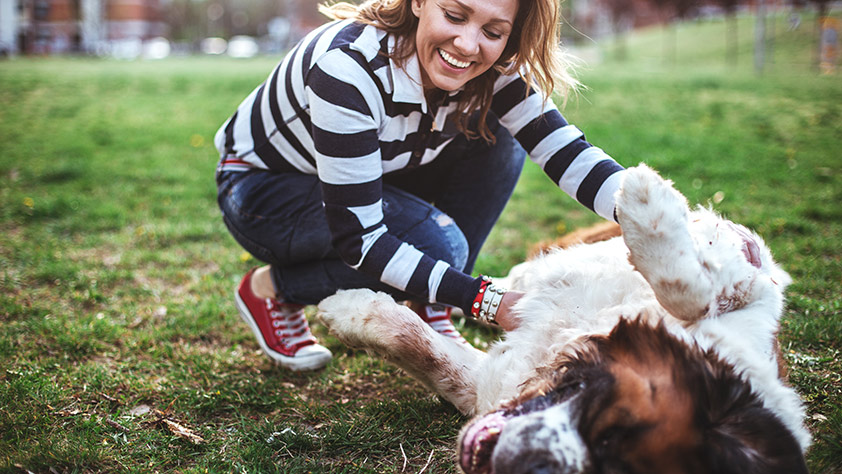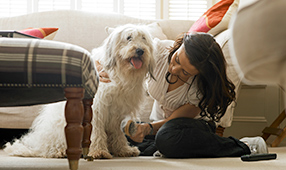Keeping your pet safe and healthy this summer can be as easy as avoiding the ABCs of pet dangers: azaleas, bees, chewing gum and more.
You may be well-schooled on the reasons to never leave a pet in an enclosed car and you may dutifully apply monthly flea and tick preventives to keep parasites off your dog or cat. But summer can be prime time for serious and surprising perils for your pet.
“As a veterinarian, I’ve treated far too many pets for heat-related conditions,” notes Marty Becker, DVM, best-selling author from Bonners Ferry, Idaho. “Heed the early signs of overheating: rapid panting, glassy eyes, drooling, acting confused, seeking shade, pacing and lying down frog-legged.”
But think beyond heat-related problems this summer. Be your pet’s best health ally by reducing their risks to these other summertime dangers:
1. Sunlight-induced burns and skin cancers. Dogs who sprint along beach shores and indoor, pink-nosed cats who seek sunny windowsills to nap share a health risk of developing severe sunburns or worse, solar-induced cancers.
“Solar-induced cancers, such as squamous cell carcinoma, are often located on the bellow, inner limbs, noses, lips, eyelids and ears of pets,” says Brenda Phillips, DVM, a board-certified veterinary oncologist on staff at the Veterinary Specialty Hospital in San Diego.
Safety tactics: Block windowsill access on your east-west facing windows to dodge the sun’s strongest rays and direct your indoor cat to window perches with plush extensions on your north-south facing windows. Or, tint your windows or install solar or honeycomb shades.
For your out-and-about dog, clad him in sun-safe pet clothing containing Sun Protection Factor (SPF) chemicals to shield his skin from ultraviolet rays on beach outings, long hikes or trips to outdoor flea markets. Apply veterinarian-approved sunscreens on your dog’s abdomen, tips of the nose and ears. Finally, perform the palm-pavement test. If the surface is too hot for your palm, it is too hot for your dog’s paw pads.
2. Bees on a mission. These buzzing insects are most active during sunny days as they go on search-and-sip missions to pollinate specific plants. Curious dogs or cats often get stung on their noses or paws.
“Try to remove the stinger as quickly as possible by using a credit card to scrape it out to stop the spread of the venom. The stinger can pulsate venom into a dog or cat for up to two or three minutes after being separated from the bee,” says Arnold Plotnick, DVM, a veterinarian who operates Manhattan Cat Specialists in New York City. “And contact your veterinarian immediately if swelling grows and your pet is having difficulty breathing.”
Safety tactics: Time your dog’s leashed walks in the morning and evening hours and steer clear of ground covers where bees are busy. In your backyard garden, select flowers such as red roses, jasmine and zinnias that attract butterflies more than bees, adds Judy Macomber, a master gardener and owner of a pet publication in Vista, California.
3. Pet-dangerous plants. Before you turn your backyard or home interior into a garden wonderland, check the Pet Poison Helpline site for a list of plants toxic to pets. Topping this list are such popular plants as azaleas, lily-of-the-valley, oleander, philodendron and daffodils.
Safety tactics: Design your backyard with pet zones and consult a master gardener in your area for pet-friendly gardening tips. Macomber recommends hoisting plants in pots out of paws’ reach and treating your pet to a healthy garden ‘salad’ bar by dedicating a section of your garden to growing these pet-friendly greens: barley, alfalfa and wheatgrass.
4. Sugar-free gum. While this calorie-free treat keeps your breath fresh, its active ingredient, xylitol, can be potentially fatal to your dog or cat, who can be drawn to the package of gum because of its shiny wrapper or because it contains your scent.
Safety tactics: Treat your gum like you do other medicines and household cleaners by keeping it in places out of access to your pet. Never leave a package of gum in an opened purse, on the kitchen counter or in your car for your curious pet to investigate by eating it.
5. Lakes, ponds and oceans. Some dogs love water play so much that they should be nicknamed Flipper. Choose your dog’s water source carefully. Avoid water that is stagnant or that has algae on it and never let your dogs swim in small ponds constructed to drain water from housing developments. They contain a lot of chemicals, such as those used on lawns.
“For dogs who do like to swim and are good at it (such as retrievers), be aware of tides, currents, rough water and high waves,” says Dr. Becker. “Enforce ‘time outs’ to ensure your dog who loves to fetch balls is rested because even good canine swimmers can drown.”
Safety tactics: Always put your water-loving dog in a canine life-safety vest. You can skip the lakes and oceans and let him frolic in a plastic kiddy pool in your backyard. Toss in floating dog toys for him to retrieve.
Parting advice: Be your pet’s best health ally by taking a veterinarian-approved pet first aid/CPR class. Knowing what to do—and what not to do—in a pet emergency when minutes count is your safest way to protect your pet.



